Physical Address
304 North Cardinal St.
Dorchester Center, MA 02124
Scapula fractures are receiving unprecedented attention in the orthopedic community, as illustrated by a simple PubMed search for “scapula fracture.” Search results provide only 82 publications in the 150 years from 1818 to 1967, followed by the 30-year span from 1968 until 1999, a period dubbed as the dark ages of scapula fracture care when these injuries were largely treated with benign neglect, and new publications appeared at a rate of fewer than 15 per year. In the 20 years since the start of the new millennium, more than twice as many publications have emerged ( n = 983) at a rate tripling the previous three decades, of 49 per year. In the last 2 years alone, 212 new publications regarding scapula fractures have been listed on PubMed. Presumably, this rapidly increasing interest is spawned by an awakening among orthopedic traumatologists and shoulder surgeons alike, to understand the nuances of scapula fractures in a way that aligns the diagnosis and treatment with that of other fractures. This phenomenon could also be related to the recognition that with significant malunion deformity of scapula comes substantial dysfunction, thus supporting the well-known AO (Arbeitsgemeinschaft für Osteosynthesefragen) axiom that musculoskeletal function follows skeletal form. As with other fractures surgically treated with open reduction and internal fixation (ORIF), rendering stability to the unstable and displaced “shoulder blade” fracture expedites pain relief and functional recovery.
Important early descriptions of scapula fractures were published in 1723 by Jean-Louis Petit, whose extraordinary work distinguished fractures of the body, neck, and processes. These fractures were first documented radiographically by Grune in 1911, nearly 200 years later. Albin Lambotte published the first report of a scapular fracture treated with ORIF in 1910. In the United States, Longabaugh reported successful operative fixation of a scapular body fracture of the distal angle, followed by a series from Reggio and then Fischer.
Despite larger surgical series emerging from Judet and others, , a subsequent period of nonoperative management was widely embraced among orthopedists as appropriate for almost all scapula fractures. , Expectant management was supported by the premise that nearly all scapula fractures heal, and the shoulder has a capacity to compensate for morbidity due to its “global motion.” This rationale was applied broadly to scapula fracture patients, except for the most significantly displaced intra-articular glenoid fractures, where there was general acceptance of the need to restore articular congruency.
The glenohumeral joint is a diarthrodial, multiaxial joint, and together with the smaller articulations of the sternoclavicular, acromioclavicular, and scapulothoracic joints ranks as the most mobile joint of the human body. , The proximal forequarter’s extraordinary mobility is also attributed to the shallow glenoid fossa in which most of the stability is maintained by the compressive loading of opposing shoulder muscles and the labrum. The shoulder capsule provides the remainder of the restraint. The dynamic relationship of the humeral head to the glenoid, with all the muscles acting across this joint, has been likened to the balance of a ball on the nose of a seal with all the adjustments necessary to maintain equilibrium. Correct muscle vectors and forces of the parascapular muscles are imperative for glenohumeral joint stability and pain-free full range of motion and shoulder strength. Scapulohumeral rhythm, first described by Codman in the 1930s, describes the interplay between the scapulothoracic joint and the glenohumeral joint with a ratio of approximately 1:2, such that for every approximately 2 degrees of glenohumeral joint motion, the scapulothoracic joint will move 1 degree. Thus the scapula acts as a mobile platform—a foundation that allows the glenoid to be oriented in a way that will resist subluxation forces and allow maximal range of motion.
Importantly, Goss first described the concept of the superior shoulder suspensory complex (SSSC) to characterize the osseoligamentous ring that includes the glenoid, coracoid, clavicle, and acromion process along with the connecting soft tissues between these structures (i.e., coracoclavicular ligament and acromioclavicular joint capsule). Goss taught that an interruption of two or more structures within this ring resulted in a disruption of the suspension system between the axial and appendicular skeleton ( Fig. 15.1 ).
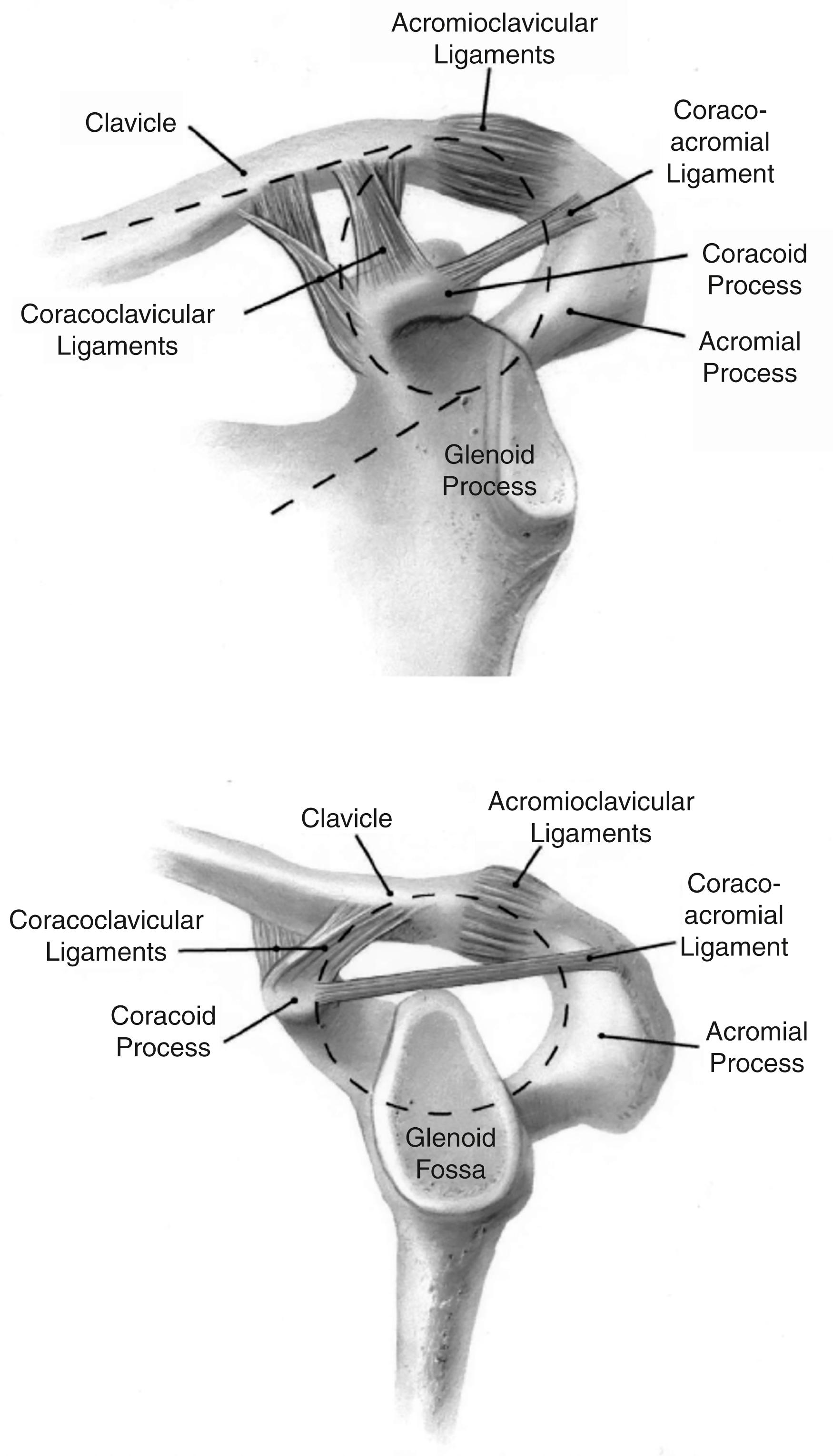
Our own recent work has also focused on the important aspects of the scapulothoracic joint allowing for gliding motion of the scapula across the chest wall. Chest wall injury, which commonly occurs concomitantly with scapula fracture, can result in abhorrent shoulder motion, impeding the patient’s full recovery from high-energy injury ( Fig. 15.2 ).
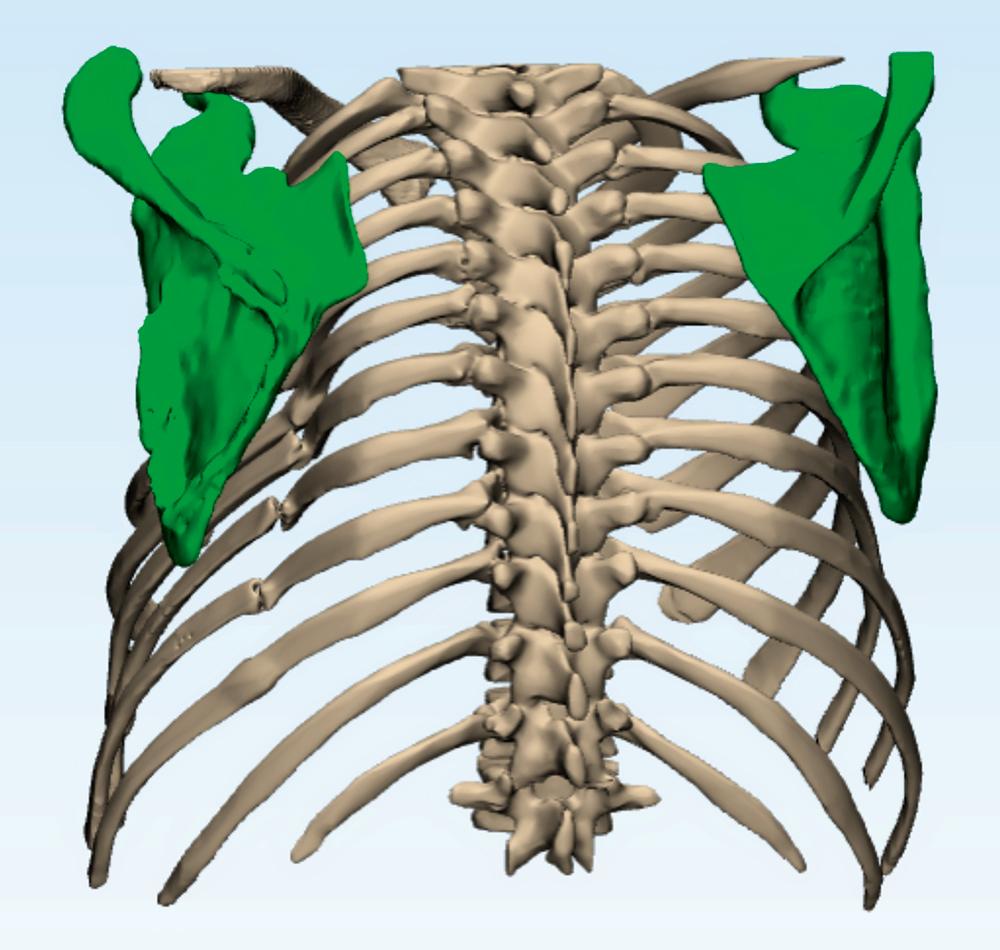
Finally, within the orthopedic arena today, a discussion of shoulder biomechanics would not be complete without consideration for the introduction of modified biomechanics and bony structures following joint replacement. Hemiarthroplasty of the shoulder (HSA), as well as total shoulder replacement (TSA) and reverse total shoulder arthroplasty (rTSA), may all be encountered in the setting of scapula fracture and the dilemmas presented to the orthopedic traumatologists. This has become especially true in regard to the growing awareness of acromion stress fractures in the presence of rTSA , ( Fig. 15.3 ).
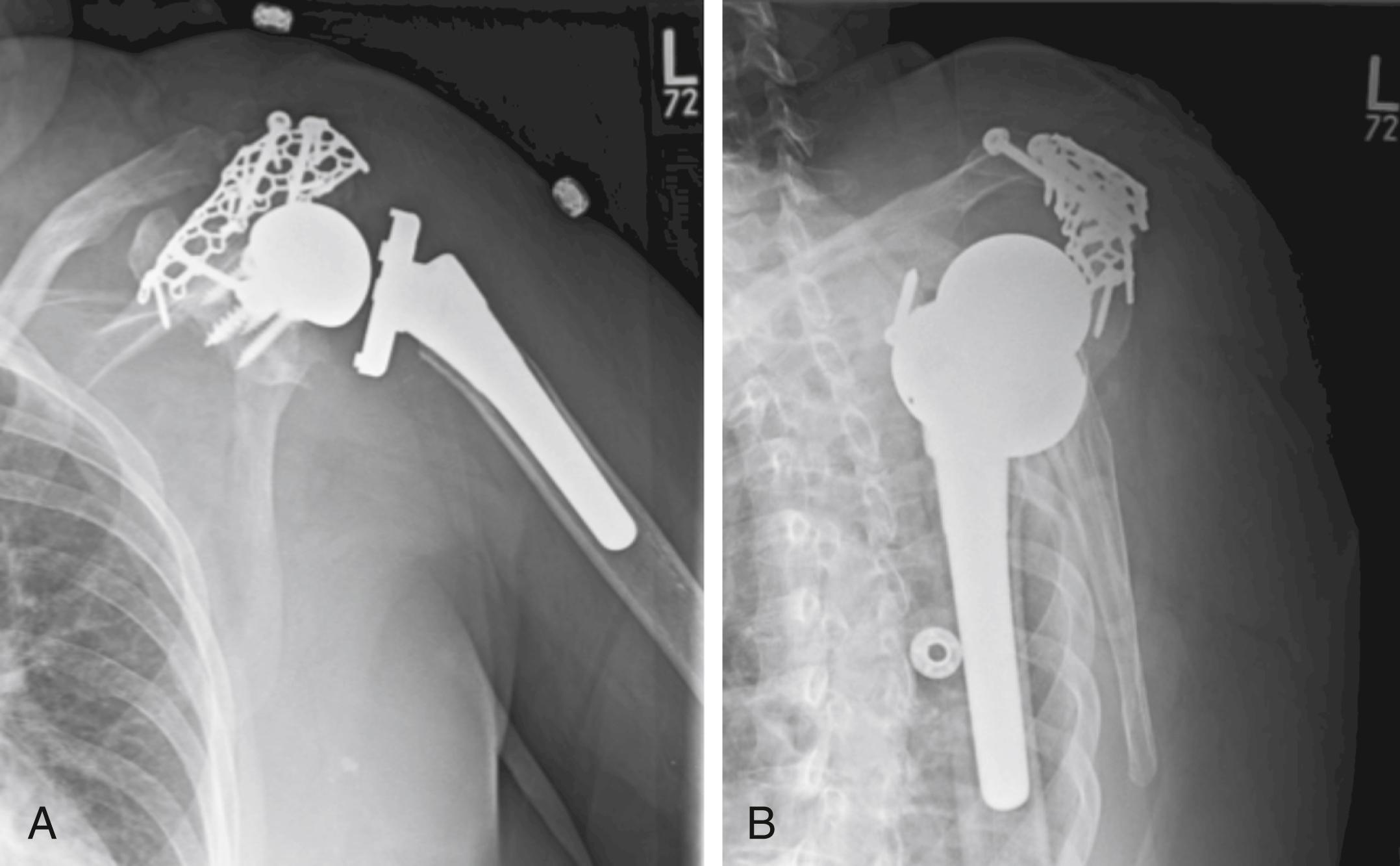
Scapula fractures have been thought to occur at a rate of <1% of all fractures. Though in epidemiological reports, they appear to occur at a rate similar to distal humerus fractures, midfoot and distal femur fractures. A recent analysis from the National Trauma Data Bank (NTDB) included a review of 106,119 patients having scapula fractures occurring within the decade of 2002–12. This study revealed a two-fold increase in the rate of diagnosis and reporting of scapula fractures coincidentally with an increase in the utilization of spiral computed tomography (CT) in most trauma patients. Other notable findings included a decrease in the proportion of scapula fractures occurring in motor vehicle accidents, with an increase in the number of fall-related injuries and an increasing proportion of these injuries occurring in the 60- to 79-year-old patient population ( Fig. 15.4 ). Similar results to these were also found in a Finnish study covering the same general time period.
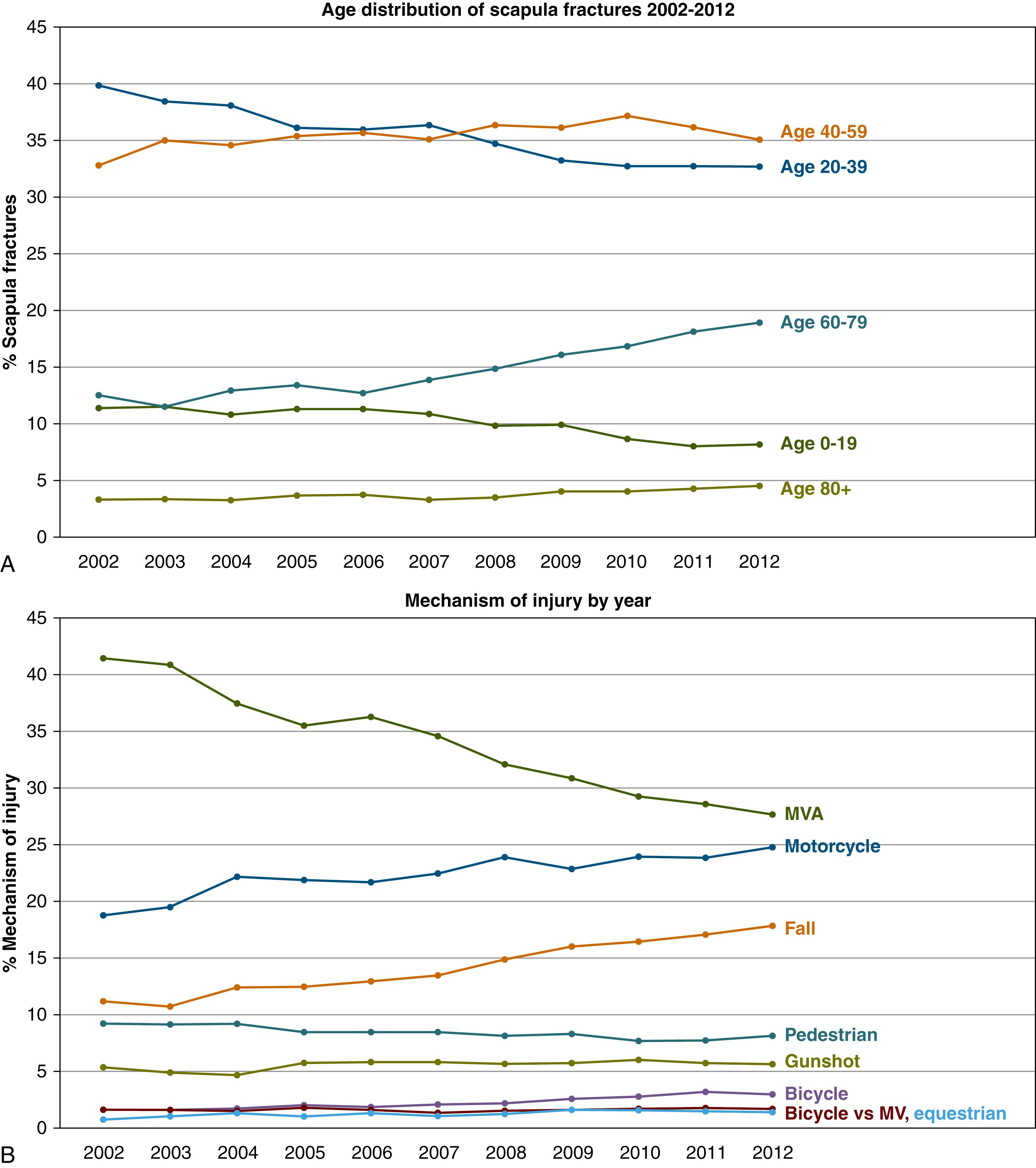
Diagnosis of a scapula fracture remains a marker of high-energy trauma in the majority of patients and is associated with concomitant injury rates of 80%–95% in operative scapula series. The most frequent combination of musculoskeletal injuries encountered includes concomitant rib fractures in >50%, , clavicle fracture (25%–39%), humeral fracture (11%–15%), and multiple disruptions to the SSSC. More recently, periprosthetic fractures have also been reported, and there is evidence that the incidence in fragility fractures of the shoulder blade is increasing. ,
Biomechanical and clinical studies of scapula fractures and forequarter injury have shown that severe displacement of scapula fractures can result in functional alterations and unsatisfactory outcomes if treated nonoperatively. An understanding of the common fracture lines where the largest amount of fracture displacement has been found to occur will give the treating physician an understanding of both deforming muscular forces acting upon the fractured scapula and the likely dysfunction which may result if the scapula is left to heal with substantial displacement, malrotation, and angulation. Armitage and Cole mapped fracture patterns resulting in displaced common patterns, which can inform the reader and assist in clinical decision-making ( Fig. 15.5 ).
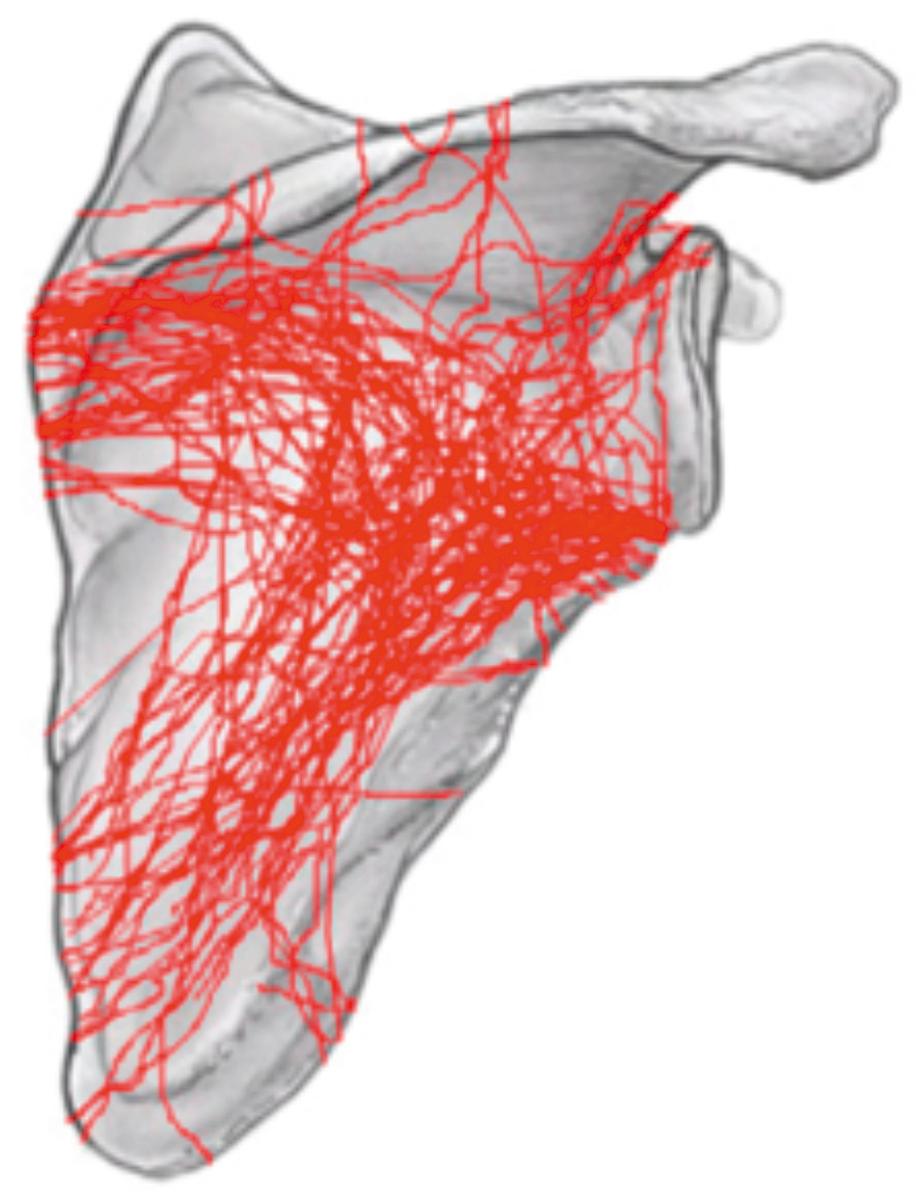
These patterns of highly displaced scapula fractures are, therefore, relevant to the work elucidating scapula neck malunions resulting in a loss of strength and altered muscle activation specifically during abduction shown in biomechanical models. As the glenoid medializes or rotates inferiorly relative to the body and lateral border of the scapula, the rotator cuff shortens taking tension off these muscles which have essential upper extremity function, including the proper loading (vector and force) of the glenoid fossa. Compressive muscular forces change to shear forces as a function of this aberrancy. Gauger et al. documented by quantitative three-dimensional (3D) shoulder motion analysis, the altered motion in a scapular malunion patient, which was shown to be normalized following surgical reconstruction of the scapula and clavicle. A series presented by the senior author at the 2017 OTA (Orthopaedic Trauma Association) described 26 patients with 34 malunions and/or nonunions of the scapula inclusive of neck, body, and process, which demonstrated statistically significant improved motion, strength, and functional outcome following scapula malunion reconstruction. In a more recent investigation accepted for publication, the treatment of process malunions and nonunions of the coracoid and acromion also reveals a morbid and dysfunctional baseline nearly completely reversible after reconstruction using a principled approach to restoring anatomy and bony union. Unfortunately, it remains unknown how much displacement resulting in malunion is tolerable to retain adequate upper extremity functionality.
Due to the high-energy mechanisms causing most scapula fractures, it is vital to perform a thorough evaluation of any patient presenting with a scapula fracture because of the high associated injury rate. , , Prioritization of injuries in terms of treatment follows full trauma resuscitation of patients. From several operative series which represent the severe end of the energy spectrum, we know a keen workup will yield positive findings for associated upper extremity fractures in up to 50% of patients, brachial plexus and peripheral nerve lesions in about 10%, significant chest injury in over 80%, as well as both cervical spine and traumatic brain injury in 15%. A thorough physical examination with a critical secondary survey alongside three X-ray views of the shoulder and a chest radiograph should provide the necessary information for clinical decision-making. We have seen a rapid adoption of spiral CT in the trauma patient over the past 10–15 years, which makes access to 3D CT reconstructions of the injured thorax and forequarter possible in most emergency centers.
In the immediate acute injury phase, an awake and cooperative patient can direct the physical examination by indicating the location of pain. Shoulder asymmetry with a slumped or depressed shoulder (so-called shoulder ptosis), if not medialized, is commonly observed. This deformity becomes more apparent in some patients, particularly those who are upright and ambulatory post injury ( Fig. 15.6 ). The skin should be inspected for abrasions and scabs, particularly over the prominent acromion ( Fig. 15.7 ). This finding should affect surgical timing.
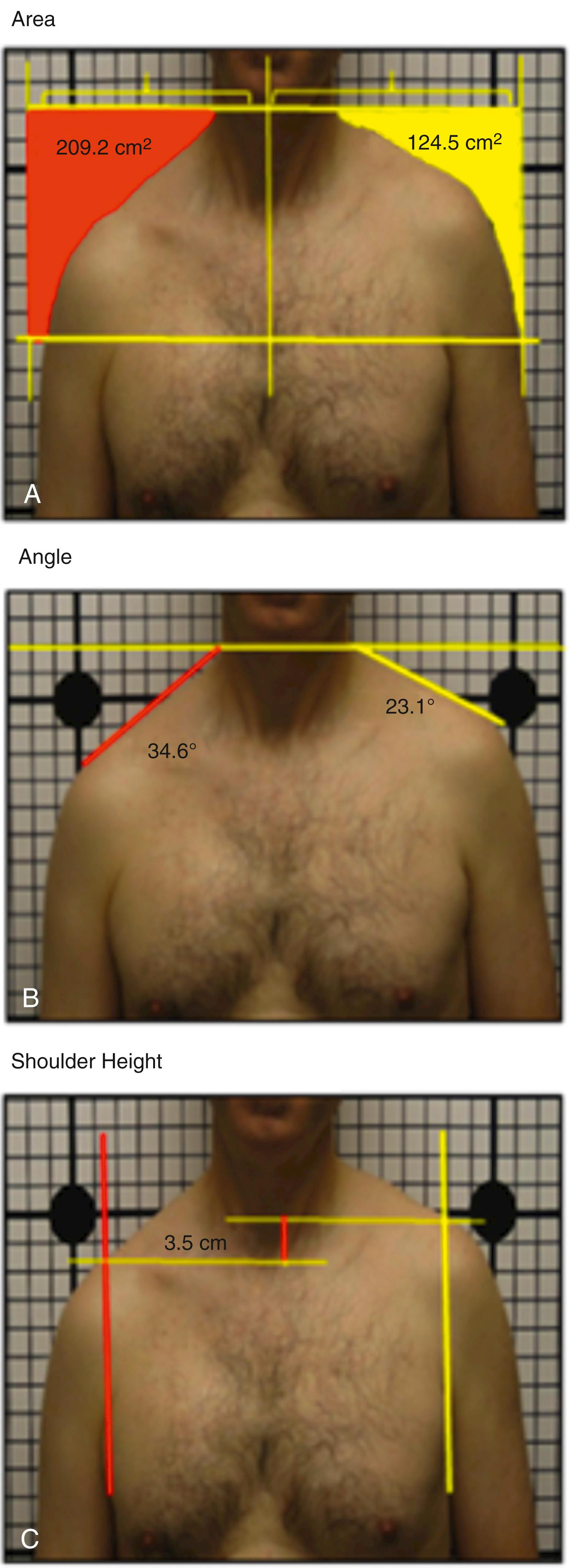
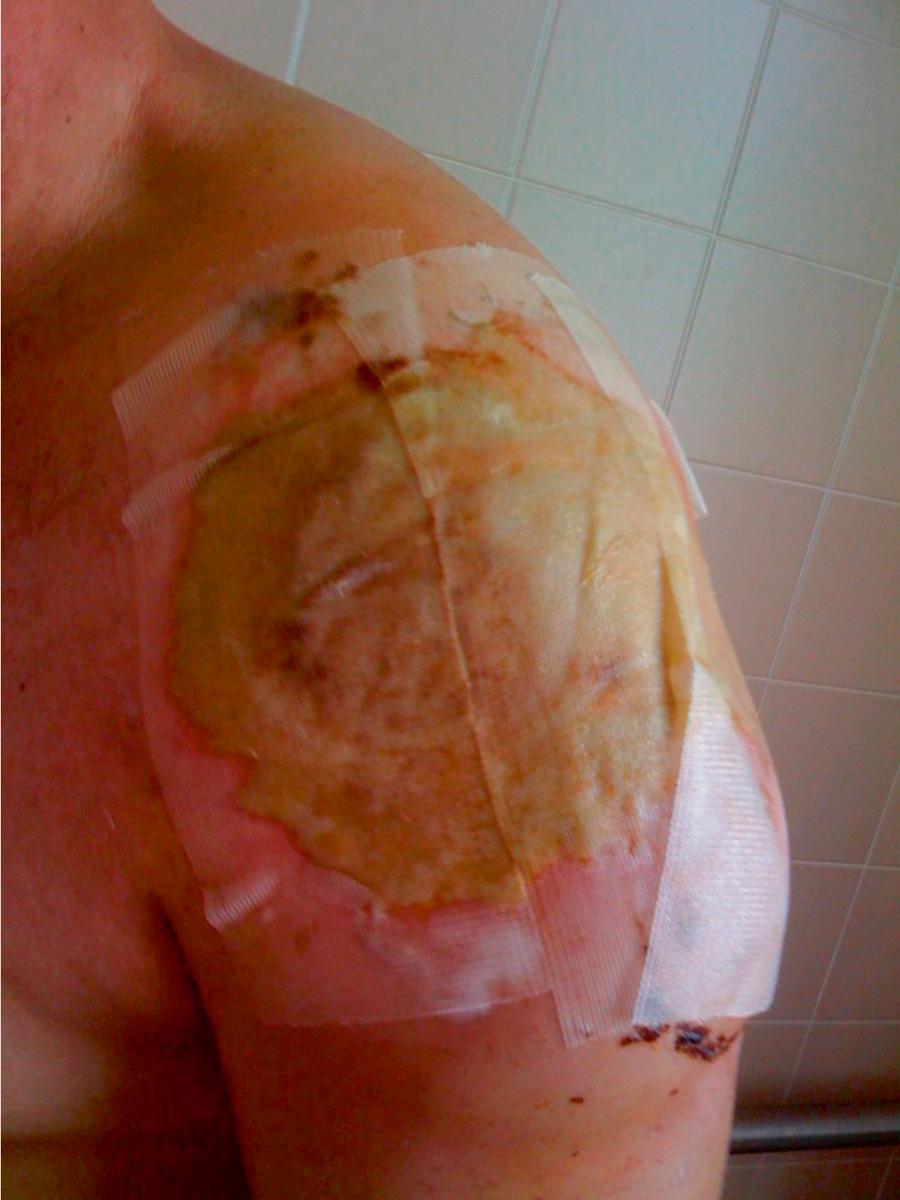
Every bone and joint should be palpated and inspected to assess for swelling, crepitance, instability, and pain. The neck should be assessed for tenderness, and deep palpation of the clavicle and thorax should be performed to direct further radiographic assessment for the common ipsilateral rib and clavicle fractures. It should be assumed that the shoulder will hurt with motion, but active forward elevation should be attempted to delineate minimally displaced variants not requiring surgery from those variants in which shoulder motion of any magnitude is extremely painful. Specifically palpate the acromioclavicular and sternoclavicular joints, sites of sometimes subtle but relevant findings. Take the wrist and elbow through a full active and passive range-of-motion examination. Next, pulses at the wrist and a detailed neurologic examination of C5-T1 should be documented.
Concomitant nerve lesions are particularly common, yet may only be detected by sensory examination because of the inability for active motion of the patient’s shoulder. A high index of suspicion for axillary and suprascapular nerve lesions should be considered with particular attention to the fracture pattern which extends through the suprascapular notch and/or scapula neck areas. Due to most patients’ inability to externally rotate because of pain, these findings often manifest later in treatment.
In the intubated or obtunded patient, palpation and motion to detect crepitation is important, including subcutaneous crepitation along the thorax and neck region, which will be positive in many patients with pneumothoraces. This finding may direct the placement of a chest tube unless already performed by the trauma service.
Upon presentation to the emergency room, a chest X-ray and CT scan will often be the first opportunity to identify a scapula fracture. Tatro et al. recently found that the routine use of spiral CT in the emergency setting resulted in a two-fold increase in the diagnosis of scapula fracture among NTDB-reported patients. Blunt chest trauma associated with shoulder pain, deformity, or the radiographic presence of other ipsilateral injuries warrants dedicated shoulder imaging. Three plain X-ray views should be evaluated: anteroposterior (AP) Grashey, scapula Y, and axillary views ( Figs. 15.8–15.10 ). It is not uncommon to be misled by displacement and fracture patterns seen on conventional shoulder X-rays. CT scans with 3D reconstructions ( Fig. 15.9 ) have proven to be a gold standard for evaluation of fracture displacement and ultimate treatment decisions. Measurement of lateral border offset (LBO), angulation, glenopolar angle (GPA), and translation of the scapula have become accepted methods forming a common language to quantitatively describe fracture displacement and deformity.
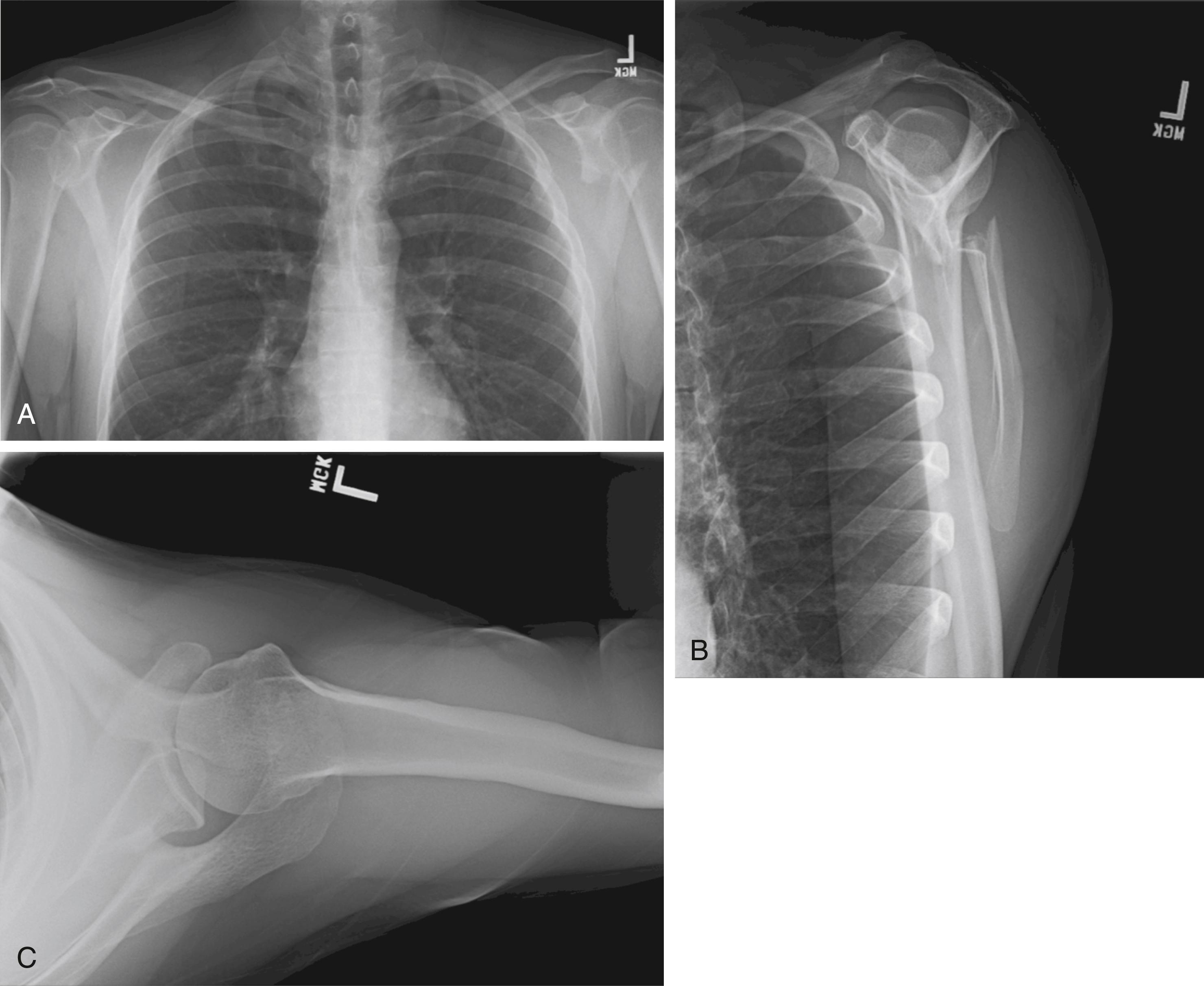
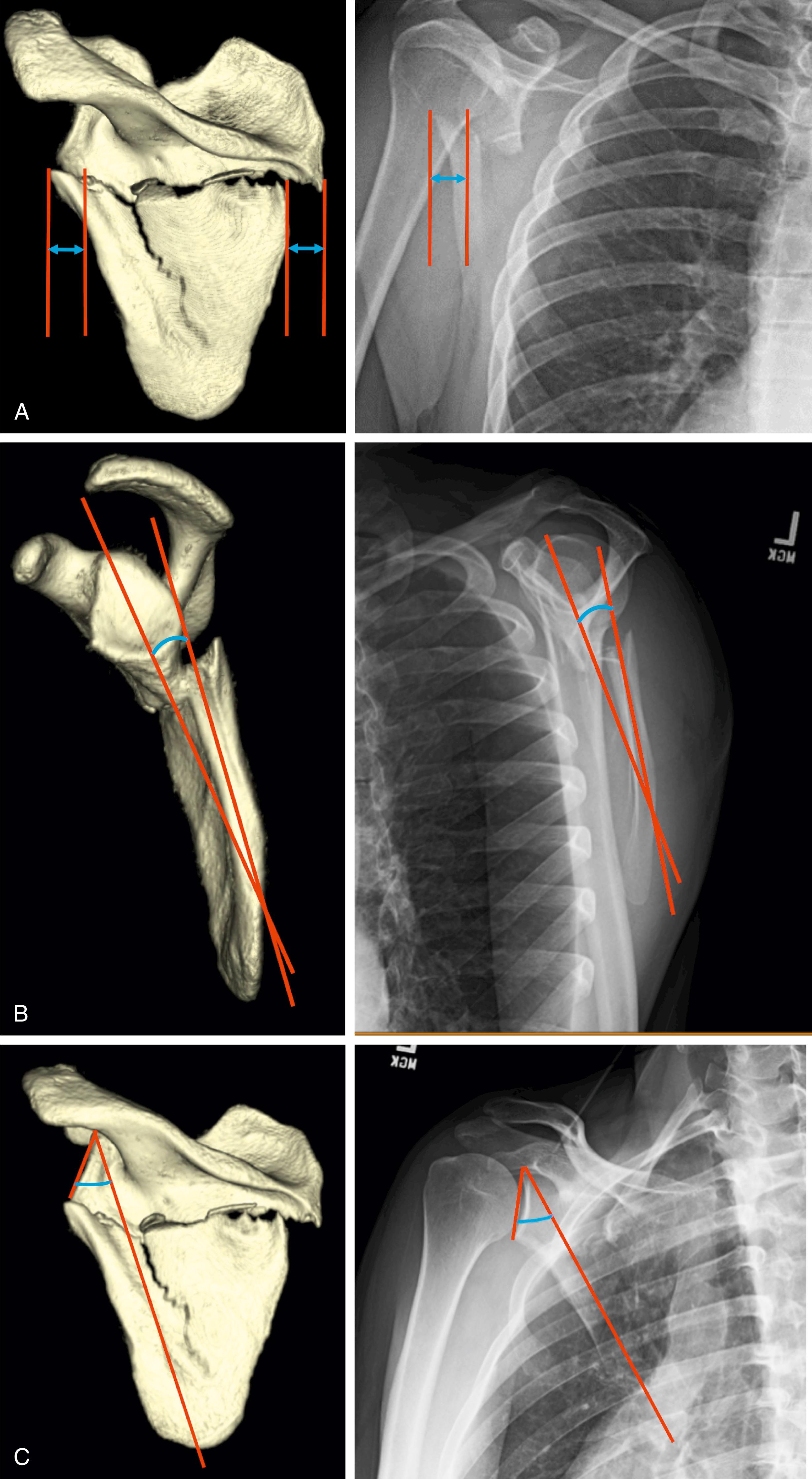
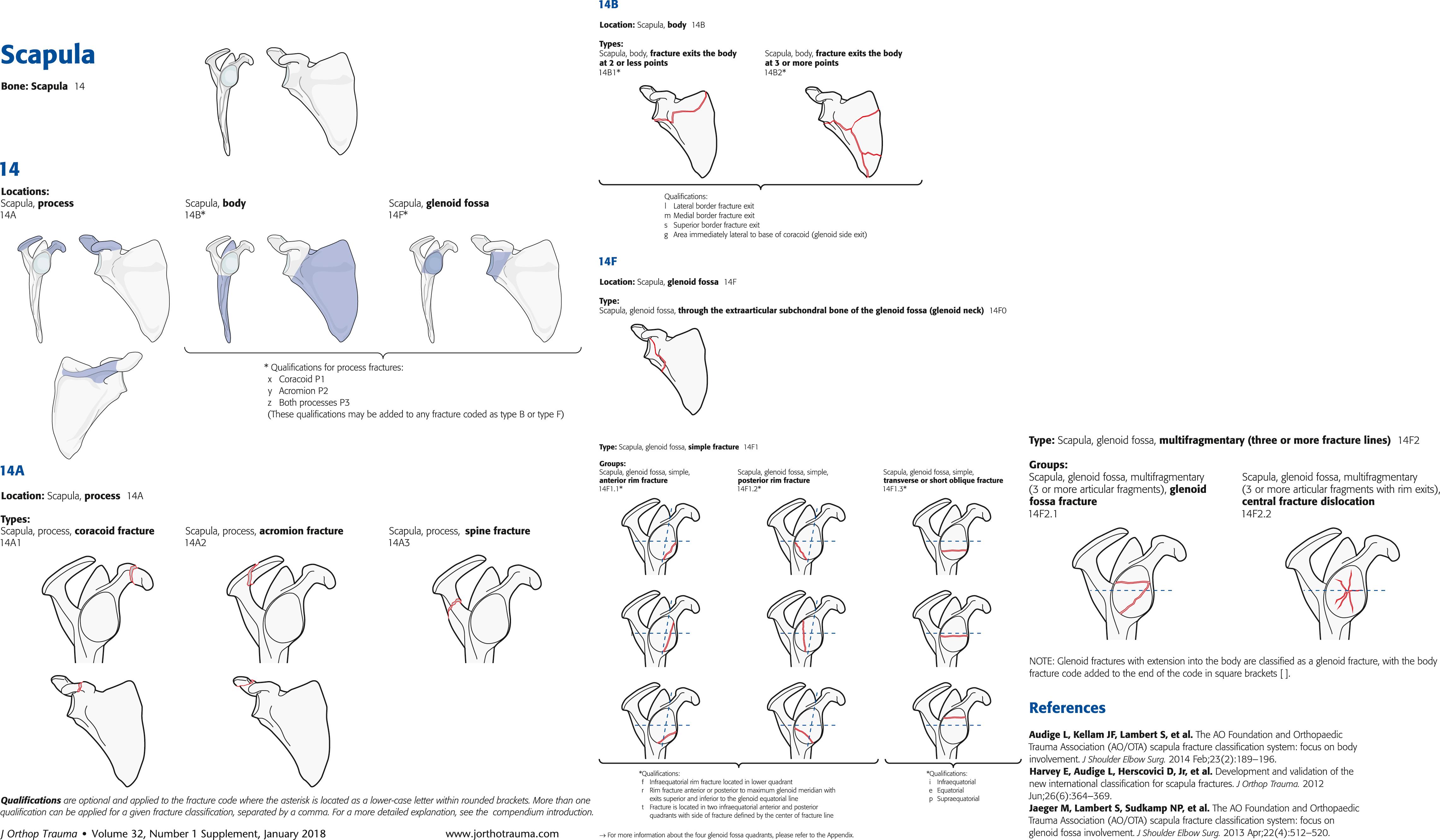
Certain extra-articular injury patterns may be prone to progressive deformity in the early postinjury period. Therefore it is recommended that serial radiographs be obtained on a weekly basis for up to 3 weeks post injury. Upright standing or seated films, when possible, help accentuate ligamentous injuries (e.g., AC separation) as the force of gravity becomes evident. Articular displacement and measurement of step-offs and gaps are best visualized on two-dimensional (2D) CT. Critical assessment of each scapula process and the articulations at each end of the clavicle is also important.
Become a Clinical Tree membership for Full access and enjoy Unlimited articles
If you are a member. Log in here